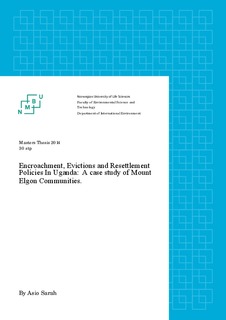| dc.description.abstract | Many protected areas have been encroached in different forms like for, land for settlement, agriculture, grazing, fruits gathering, hunting, tree cutting and other forest resources by surrounding communities and this has led to degradation of ecosystem in many protected areas. Due to the realization of the degradation of the protected areas, this has led to a call for conservation from different organizations worldwide so as to save the ecosystem which is being destroyed. Conservation is done through eviction and resettlement of the ‘encroachers’’ from the protected areas.
As the main objective, the study seeks to establish the scope of encroachment, eviction, and resettlement and to investigate the livelihood impacts, copying mechanisms and the laws and policies on evictions and resettlement of communities around Mount Elgon conservation area.
The specific objectives of the study included:
1. To establish the spatial and temporal scope of encroachment, eviction and resettlement around Mt Elgon National Park.
2. To establish livelihood impacts and copying strategies of evicted communities.
3. To find out the extent to which the existing national and international laws and policies on eviction and resettlement have been respected.
There are two conceptual frame works applied in the study, that is, Sustainable Livelihood Approach and Human Right Based Approach.
The main methods used in this study are key informant interviews, household structured and unstructed interviews, focus group discussions, and observation designed based on the concept of Participatory Rural Appraisals (PRA) used for gathering information from the local communities. Both qualitative and quantitative methods were applied in the study.
Purposive and simple random sampling techniques were applied in the study as elaborated in the later pages.
The results of the study revealed that, despite the conservation initiative around Mt Elgon, there is still encroachment going on around the park. Drivers of encroachment include, population growth, need for increased production, insecurity, political influence, infertile land around communities adjacent to the park, among others. The forms of encroachment among others include, land for agriculture, building, livestock grazing, hunting wild animals, collecting forest products, and tree cutting.
The results also reveal that, the evictions have continued since the first evictions conducted in 1983 to the current ones conducted in 2010. But the magnitude has reduced from 5000 households evicted in 1983 to 48 households evicted in 2010 from Mt Elgon. It shows decrease in number of households evicted.
Results also reveal that, resettlement has continued around Mt Elgon right from 1983 up to the recent one conducted in 2010. It goes ahead to reveal that, out of 5000 households evicted in 1983, 2872 were resettled permanently in the Benet Resettlement Area in 1983. There is no record of 2128 household who were not resettled in 1983 evictions, although the evictions and temporal resettlement have continued sine the first evictions in 1983 around the slope of Mt Elgon. For instance, the people in Amanang parish resettled temporally in 2008 around the lover slopes of Mt Elgon. The recent resettlement took place in 2010 in Zesui parish in Sironko District, 48 households evicted and all of them were resettled which clearly shows the number of households evicted and resettled has reduced in 2010 compared to the ones in 1983.
However, despite the spatial encroachment, eviction and resettlement, the results reveal that, most of the people evicted are not given proper compensation and the ones who get resettled, always find themselves in infertile lands like the people of Bukwo and these has prompted people continue to encroach the park in search for fertile land for cultivation.
Results reveal that, Eviction and resettlement have created an impact on the livelihoods of the local people through the constrained access to the various forest resources people have been enjoying before eviction. As a result of eviction and constrained access to forest resources, people’ livelihoods have changed. Most of the people lost their property in the process which affected them so much. As coping strategies, the local people had to diversify their livelihoods. Some of them hard to begin working on the farms of other people as one way of sustaining their livelihood as elaborated in the later pages. The most vulnerable ones who failed to cope up are living under poor living conditions for example the people of Kapkwata camp who claim not to have land to build and for even cultivation for home consumption.
The findings clearly show the contradictions in implementation of policies and laws governing eviction and resettlement processes. The evicted people claim that, the policies and laws were not respected while the Uganda Wildlife Authorities claim that, the policies were respected. Putting it in line with what other writers like, Luzinda (2008) and Vangen (2009) wrote that, the evictions and resettlement around Mt Elgon were characterized with lot of violence and massive loss of property as discussed in the later pages. The results reveal that, the policies and laws were not followed when it come to eviction and resettlements despite their existence.
In a nut shell, despite the fact that, encroachment, evictions and resettlement have been taking place around Mt Elgon National park, it’s been difficult to establish the temporal scope of encroachment, eviction and resettlement due to varying statistics different researchers or writers have presented. This made it hard for the researcher to come up with exact figure of people who were evicted and resettled as all the figures were accessed from Uganda Wildlife Authority reports which may be biased based on their own reasons.
The contradictions in respecting the policies and laws on encroachment, eviction and resettlement, call for follow up as joint effort towards implementation of law and order especially in regard to practices that uphold both conservation and respect for human rights and local livelihoods so as to achieve the goal of conservation in the protected areas. | nb_NO |
